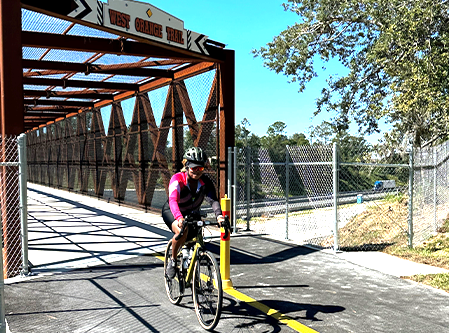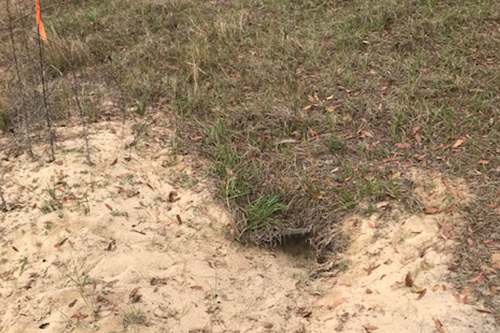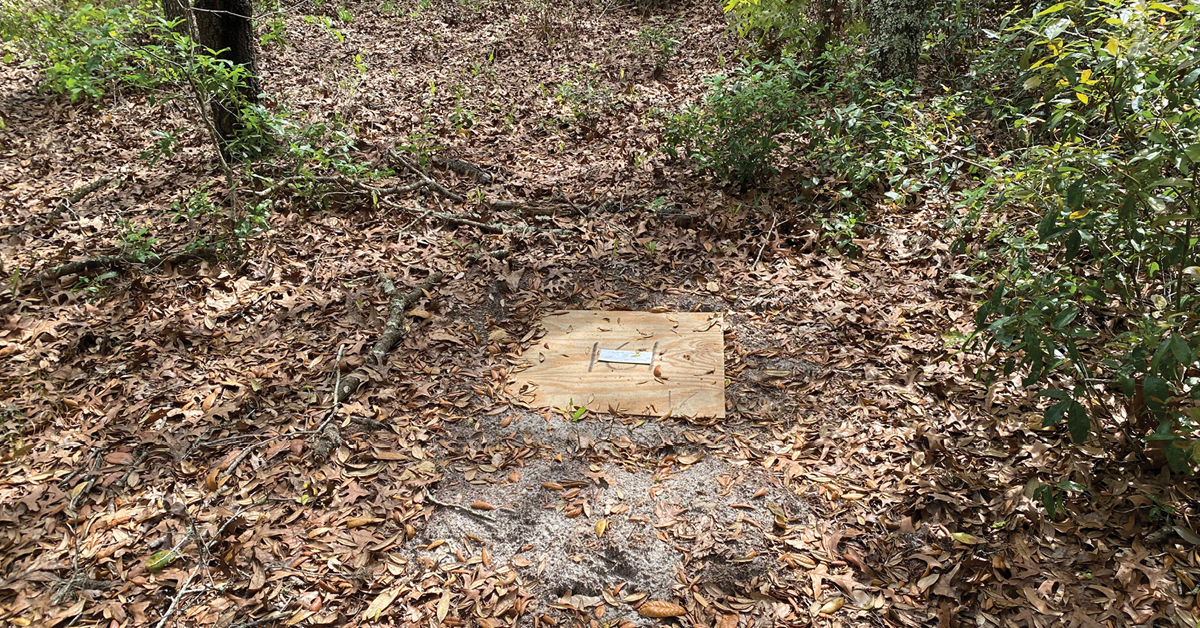In the heart of Central Florida, sprawling across vast acres of land and bodies of water, you’ll find a haven for countless species of wildlife, including alligators, black bears, bobcats, manatees, deer, snakes, gopher tortoises, and birds.
There’s a delicate balance between protecting this critical wildlife habitat and its native species while also meeting the demands of development. This is where DRMP’s Environmental Services experts play a critical role in ensuring transportation projects align with the stringent guidelines set by federal and state environmental protection laws.
Orange County, Florida, is proposing to construct the Lake Apopka Trail Connector from the Lake Apopka Trail Loop to the 22-mile West Orange Trail, a popular and widely used tree-lined trail near Orlando for cycling, jogging, and other recreational activities.

A cyclist rides on the West Orange Trail
The proposed trail would include a 10- to 14-foot-wide asphalt multi-use trail that will link the West Orange Trail to the Lake Apopka Loop Trail from Magnolia Park to McCormick Road, covering a 4.8-mile stretch. The purpose of the proposed trail is to connect the trail systems of Orange County, the St. Johns Water Management District, and Lake County.
DRMP is providing ongoing environmental services for this project as a subconsultant to WBQ. Our firm is providing environmental permitting services, wetland and surface water assessments, and threatened and endangered species surveys.
Sand Skink Coverboard Survey
One of the more interesting aspects of this project was surveying the proposed new trail limits for the presence of the state and federally protected sand skink (Neoseps reynoldsi). A sand skink is a small, sleek grey or light brown lizard with shiny scales protected as a “threatened” species by the federal Endangered Species Act and by Florida’s Endangered and Threatened Species Rule. Sand skinks can reach a length of 5 inches and are exclusively found on sandy ridges of interior Central Florida.
The project is located within an area designated by the U.S. Fish and Wildlife Service (USFWS) as a sand skink consultation area, which means suitable habitat may be present in this area. The three most important factors in determining the presence of skinks are location, elevation, suitable soils, and a distinctive sinusoidal (“S”-shaped) track.

A coverboard survey identifies a mole skink
Surveys can be conducted throughout the year; however, tracks are most visible in the spring and fall. Visual pedestrian surveys were conducted to confirm these parameters were met, and suitable sand skink habitat was present.
The pedestrian survey indicated the project area did meet the criteria for suitable habitat for sand skink, but no tracks were detected. Per the USFWS survey protocol, if the pedestrian survey is negative for tracks or some portions of the site were determined not occupied, then a coverboard survey is necessary to reach a presumed absence conclusion. Coverboards, which consist of 2 foot by 2 foot plywood, are strategically placed within specific areas of bare sand or sparse vegetation. Prior to initiating coverboard surveys, we coordinated with USFWS biologists to gain concurrence on our proposed survey approach, such as survey dates and coverboard locations. When we surveyed the project area for sand skinks, we separated the survey area into two designations: Survey Area West and Survey Area East. Survey Area West is the proposed trail limits west of State Road 429 (SR 429), and Survey Area East is located east of SR 429. The two areas contain approximately 0.78 acres of suitable sand skink habitat.

One of several coverboards used to survey for sand skinks
Our survey entailed strategically positioning eight boards within the western survey area, spanning 0.20 acres of suitable sand skink habitat, and deploying an additional 27 boards in the eastern area, encompassing 0.58 acres of similarly favorable sand skink habitat.
We meticulously checked each coverboard weekly for four weeks looking for the unique “S” tracks of the sand skink; however, our survey came back negative. Though our coverboard survey did not find any evidence of sand skinks, we did observe numerous other elusive critters, such as snakes, small mammals, and a mole skink, which is a similar looking lizard but is not protected. Since our coverboard survey produced negative results, we submitted our survey results to USFWS and got concurrence that the proposed project trail “may affect, not likely to adversely affect” the sand skink.
Surveying for Gopher Tortoises
The gopher tortoise, recognized by the Florida Fish and Wildlife Conservation Commission (FWC) as a threatened species, inhabits dry upland habitats and pine flatwoods. More than 350 other species of animals, known as commensal species, benefit from burrow systems created by gopher tortoises.
Due to the presence of potentially suitable habitat within the project area, DRMP undertook a comprehensive gopher tortoise survey. In my capacity as the Project Manager and an FWC Authorized Gopher Tortoise Agent, I personally conducted a survey of all the suitable gopher tortoise habitat within the project limits looking for gopher tortoise burrows.
During this process, I observed several potentially occupied gopher tortoise burrows within the project area and its immediate vicinity. All gopher tortoise burrows located within the project area or within 25 feet of the proposed project footprint are considered impacted burrows and are required to be excavated/relocated prior to the commencement of construction.

A gopher tortoise burrow
It is anticipated the proposed project will impact less than 10 gopher tortoise burrows and will qualify for an FWC gopher tortoise relocation permit, a crucial step DRMP will promptly secure on behalf of the client.
The Lake Apopka Connector Trail is one example of many projects in which DRMP demonstrates our commitment to environmental stewardship among the comprehensive services we offer. I’m proud to be a part of a robust team of scientists doing our part to help safeguard the environment.

















